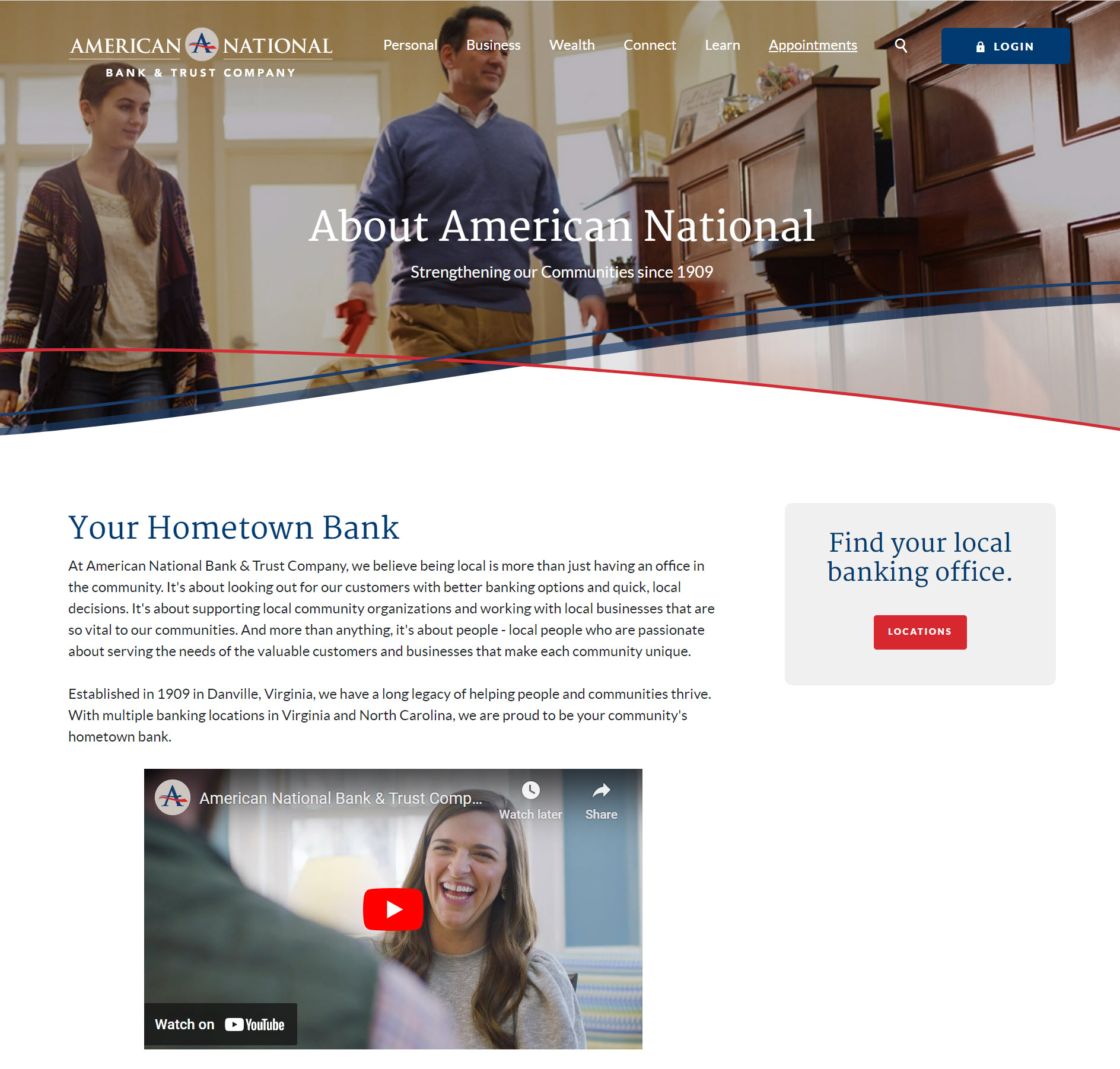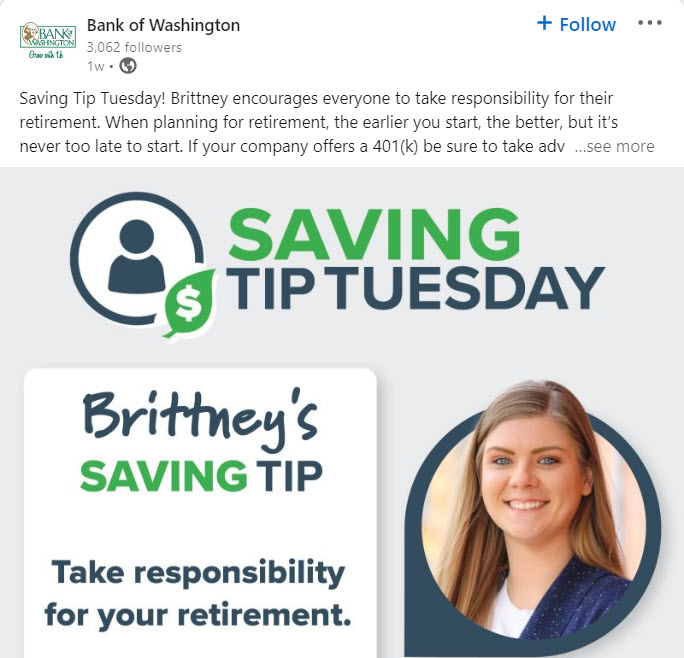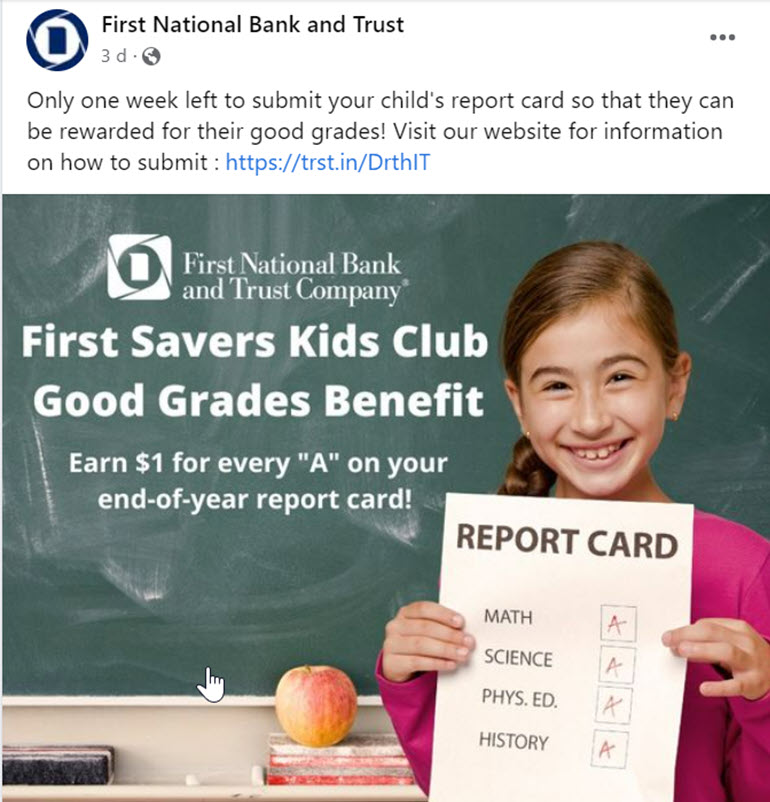Bank Marketing Strategy
“A picture is worth a thousand words,” but does that still under-rate the importance of visual content in bank marketing? After all, 90% of the information our brains process is visual and it only takes 12 milliseconds for the human brain to process an image. Financial institutions can use this visual orientation to their advantage to drive audience engagement and customer acquisition. Keep reading to learn about seven visual content strategies that can help increase your FI’s digital marketing ROI.
1. Be relatable.
The familiarity principle means that people tend to gravitate towards people, places, and things they already know. Familiarity can feel safe and it also makes people feel like you “get” where they are coming from by describing situations that resonate with them. For example, you could incorporate visuals that depict local landmarks in your community. If you have a lot of ag customers, use photos of local farms and the types of crops that are popular in your area.
However, familiarity is subjective. It’s important to design visual marketing materials with diversity and inclusion in mind. That will help you provide familiarity for everyone in your target audience. Customers and prospects are more likely to identify with your bank if they see other people who look like them on the website, in brochures, and in other marketing materials. Using inclusive visual content in marketing collateral is a way to demonstrate a commitment to diversity and to attract a diverse audience.
Finally, you can’t be relatable without being authentic. The visual content you use should accurately represent your financial institution based on location, target audience, history, products and services, etc. Using visual content that isn’t representative of your FI is detrimental to your image.
American National Bank & Trust about us video @ amnb.com

2. Be aware of what you don’t want to convey as much as what you do.
When creating visuals for your marketing content, it’s best to have several people review images before publication. While one person may see a simple message in a piece of visual content, another may pick up on something potentially undesirable.
For example, the pandemic may be over, but some people are still wary of germs, close quarters, crowds, and anything else that will compound health and safety concerns. So, a visual campaign about travel could inadvertently trigger anxiety in some viewers.
You also want to make sure that your visual content is displayed correctly on all devices. The last thing you want when you’re trying to engage customers and prospects is to have an image cut off due to being sized wrong. Web content is now consumed on a variety of devices and screen sizes, especially smartphones, while new forms of visual content like VR video are becoming popular.
3. Set realistic expectations.
There are many factors to consider when it comes to choosing the right visual content for your credit union or bank’s digital efforts. You may want to create a set of rules or guidelines for your internal marketing team and external vendors to follow. For example:
- Try to keep visual content current such when it comes to products, people, buildings, and so on.
- Avoid visual content, such as images, that are overly staged or posed. Natural is best and more relatable to customers.
- Pick tasteful visual content with good quality in the best format for the medium such as print or web.
- Stay within your budget. Not everyone can afford original visual content shot by a high-quality commercial photographer or videographer.
- Avoid stock photos or canned ‘B’ roles if you can. Some can make your bank look dated or generic or–even worse–negatively affect your brand.

4. Get social.
Social media can be a great place for professionals and businesses to share informational and educational content. You can increase your posts’ chances of being noticed and shared by including visual content such as a photo, drawing and even an infographic or video that brings a concept to life. Other ways to boost your social media presence include:
- Add social media buttons to your visuals to encourage engagement and sharing.
- Share images and video across all your social channels. Did you know Facebook posts with photos get 3x more engagement than those without them?
- Share content with a link to the original blog post and in the format of an image post.

5. Appeal to people’s emotions.
Incorporate principles of psychology into your visual content to influence or provoke emotional reactions to your marketing. Here are two examples:
If the goal is increased brand awareness, relationship building, and sharing of valuable and practical information, you want to utilize visual content to compel and engage the emotions of your audience to the extent that they will want to share. You could use images of community or bank events in this case.
If the goal is moving someone to the next phase toward an action, such as deposit account acquisition, utilize sales psychology to stimulate the emotional responses necessary to achieve certain actions. Essentially, the message is that you can solve the prospect’s problem or relieve their pain through purchasing a product or service I am selling. To support this message, you could use how-to videos or images of people getting assistance from bank representatives.

6. Adhere to copyright laws that protect every visual image.
Sharing a copyrighted image can make you liable for infringement, even if you unknowingly share it. Violation of copyright laws can result in severe penalties and legal repercussions.
The easiest way to determine whether an image is copyrighted is to make it yourself. For creative works, this means that you own the copyright. If you don’t have an in-house graphic designer, working with an agency like BankBound will give you access to original and uncopywrited images for blog content, social media posts, web pages, email marketing, etc.
You can also use sites like Unsplash, Pexels, Shutterstock, and more to find free images. Just pay attention to the rules surrounding use–usually you need to credit the owner of the photograph when you use it.
7. Optimize for SEO
Over the past couple of years, image searches have increased significantly. Due to the evolution of search technologies, the results have become more reliable. Your visual content is very important for content marketing success. High quality, optimized images can help boost engagement, increase click-rates, and attract more attention. Having the right images can also help boost your social media and SEO presence.
To get the most out of your images, you should optimize them for search engines such as Google, Bing, and Yahoo. Research effective keywords to use in image descriptions so you can boost their visual search results and attract more viewers.
When it comes to optimizing your images, one of the most important factors to consider is the inclusion of the Alt tag in source code. This will help search engines identify and index your image properly.
Cross-promoting your visual content in different formats and sizes can also extend its reach and increase the number of people who visit your blog. Social media automation tools can help you manage and distribute your visual content more quickly.
Get help with your visual content marketing strategy!
From creating infographics to supporting SEO with engaging, original images, BankBound’s team of content marketing specialists can help your bank or credit union get the most out of your content marketing strategy. Contact a digital marketing nerd today!

